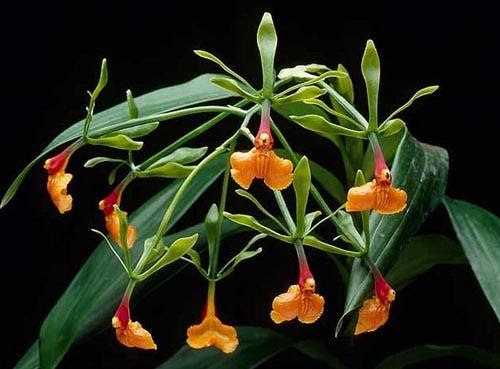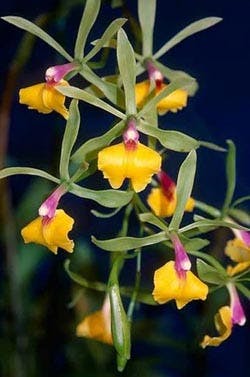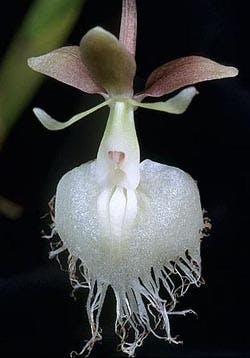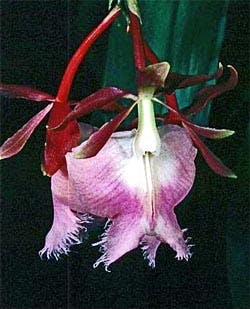Epidendrum pseudepidendrum and Epidendrum ilense are two species worth growing in greenhouses and tropical gardens — By Ned Nash

Epidendrum pseudepidendrum 'Rudolph' CHM/AOS exhibited by Woodstream Orchids. Photo by James Osen.
Once upon a time, all orchids were classified as Epidendrum. Linnaeus established the genus as part of his binomial system in 1753, and so few orchids were known at the time that it seemed to make sense that all orchids should be included in this broadly defined group. Consequently, as more orchids were discovered, it became clear that they needed to be reclassified into more genera to accommodate the many differences in their morphology. However, and especially until the last few decades, Epidendrum has remained a classical catch-all genus with broadly defined characteristics.
As more and more sophisticated taxonomic work is possible, more and more genera seem to emerge from what were once familiarly known as Epidendrum. Prosthechea, Barkeria, Encyclia and Psychilis are a few of the better known of the more modern interpretations of this widespread New World group.
Today, what are most properly called "epis" are the reed-stemmed plants with the lip adnate (attached) to the column. These are generally robust plants, well exemplified by the commonly seen and brightly colored Epidendrum ibaguense complex, which are such popular garden subjects where frost does not often threaten. There are some dull and prosaic plants in this group, as well as a few that are exotically distinct and different. Thereupon hangs our tale.
Cultural Needs
Here we want to discuss one of the most recently described of the genus, Epidendrum ilense, and one of the longest-known, Epidendrum pseudepidendrum. Both are characteristic of the genus, growing to 3 feet or occasionally more, with attractive foliage on reedlike canes and slightly drooping inflorescences of several to many blooms. Both will also branch off old spikes, so do not be too quick to remove the withered spikes. And both will do well under generalized cultural conditions prescribed for cattleyas - bright light (as for other cattleya types, indicated by strong, upright foliage and a medium-green color) with drying between waterings (this will vary according to pot size, mix, climatic regime and growing area).
These plants are remarkably tolerant in their potting mix needs, as well. They will succeed in just about anything that drains well, from medium- or fine-grade fir bark, to tree fern, to mixtures incorporating such materials as charcoal, peat, perlite or coir (coconut fiber).
Fertilizer should be appropriate to the mix used. If grown in a bark-based mix, the nitrogen will need to be a higher ratio (often 30-10-10 or similar), while in other mixes it is appropriate to apply a balanced fertilizer. The only cultural drawback seems to be a propensity to foliar spotting. Their foliage is a bit on the soft side, and so seems to be more susceptible to leaf spotting that may be caused by cold-water injury to the leaves,with subsequent necrosis, according to Jim Rose of Cal-Orchid, Inc. He notes that observant growers have less spotting on their plants than careless ones, so keeping water off the foliage may be an answer.
Owing to their height and light requirements, neither of these two species can really be considered satisfactory for windowsill culture, nor easy under most light set-ups. They are both more appropriate to greenhouse conditions or to tropical shade gardens, where they will often acclimatize in the landscape, making an attractive addition in or out of bloom. In the garden, they require shade from the hottest sun of the day, while in the greenhouse, they can be grown under the same conditions as cattleyas and similar types. Their main season of bloom tends to be late summer into autumn, though it is extended well into the autumn months by the repeat-blooming characteristic.
Epidendrum pseudepidendrum
Epidendrum pseudepidendrum, with its nodding spikes of fleshy apple-green blooms offset by a brilliant orange lip, has been a favorite for many years. Originating in Costa Rica and Panama, today's populations are seed-grown, but only occasionally available.

Epidendrum René Marqués 'Caribe' exhibited by Caribe Plants Inc., photo by Mei-Ling Melendez.
The two earliest hybrids with this plant appeared around the turn of the century — Epidendrum Langleyense (x wallisii) in 1899 and Epidendrum Cleon (x radicans) in 1906 — so it is clearly a species that has stood the test of time. However, no hybrids were registered between the two earliest crosses and the 1960s, when Goodale Moir took up the torch with a series of hybrids including an early Epicattleya (Epc. Charles Lankester [x C. Firefly] 1960). Subsequent hybridizing was often with other, often uninteresting and obscure,
Epidendrum species, and so in many cases the resulting grexes were not particularly popular or well known. Some lines were carried on into the second and third generation, with the 1980s being an especially active time for second-generation hybrids from Epi. pseudepidendrum (17 registrations.) Otherwise, activity over the last 30 years or so has been fairly well distributed in each decade, with only a high point worthy of note here or there.
A cross that is occasionally seen at shows is Epicattleya René Marqués (x C. Claesiana). Looking much like a slightly larger, improved epidendrum, Epc. René Marqués makes an impressive showing on plants that may reach more than 4 feet tall. This hybrid also demonstrates one of the drawbacks of epidendrum breeding: the exceeding dominance of the epidendrum parent. When one begins to research into some of the more obscure breeding lines, such as we have here, the byways traversed by adventurous breeders are nothing short of amazing.
One of the true pioneers of intergeneric breeding, after, of course. W.W.G Moir, has to be Joseph Rumrill. He has been no less active with Epi. pseudepidendrum than with other unusual types, and one of his most intriguing hybrids is Epileptovola Hyperion (x Lptv. Rumrill Snow [Leptotes bicolor x Brassavola nodosa]). Not unexpectedly, another of the few well known hybrids is Brassoepidendrum Pseudosa (x B. nodosa). Rather like a good soft drink, everything seems to go better with B. nodosa. One cannot ignore Epidendrum Plastic Doll (x ilense), which was registered in 1989.
Epidendrum ilense

Epidendrum ilense 'Magnifico' AM/AOS exhibited by Mrs. Ralph Levy, photo by Marcus Valentine.
Epidendrum ilense is one of the most recently discovered and described members of this genus, having been found by Calaway Dodson, PhD, in a section of recently cleared forest in Ecuador in May 1976. It was subsequently distributed by the Marie Selby Botanical Gardens in Sarasota, Florida (see page 1083 in the September 1981 AOS Bulletin). Sadly, when Dodson went back to the locale, he found that the several plants he had collected from fallen trees were all that remained of the population. On a happier note, and though Dodson's early attempts met with failure, Epi. ilense has proven to be relatively easy to propagate from both tissue culture and from seed, so now there is a stable supply of nursery-raised seedlings in a case not dissimilar to that of Paphiopedilum delenatii.
The typically nodding spikes borne over light green, rather softly foliaged canes bear distinctive blooms with a most unforgettable fringed lip. As with Epi. pseudepidendrum, the spikes have a habit of reblooming. And also as with the previously discussed species, Epi. ilense seems to be dominant in its breeding characteristics. Both because of its fairly recent discovery, and because it seems to be one of those orchids that is best left alone (because it is more handsome than its hybrids), relatively few hybrids have been registered with Epi. ilense as a parent.
Besides the previously mentioned Epi. Plastic Doll (x pseudepidendrum) — which, interestingly, has been used as a parent to make Epidendrum Petit Doll (x criniferum) — probably the best known of the five hybrids registered to date is Epicattleya Dormie (x C. Dormaniana), which has received an AOS flower-quality award.

Epicattleya Dormie 'Magnifico' AM/AOS exhibited by Mrs. Ralph Levy, photo by Marcus Valentine.
For students of orchids who love anecdotes and history, odd and unusual plants and hybrids, there are probably no better examples of truly good orchids than these two species. Worth the little bit of extra effort to search out and grow well, these plants and their hybrids will reward the diligent hobbyist with foliar and floral beauty, as well as a wealth of stories with which to amaze the less-informed.
Ned Nash is a former Director of Conservation and Education of the American Orchid Society. This article first appeared in ORCHIDS, November 1997 and has been updated to reflect current taxonomy.









